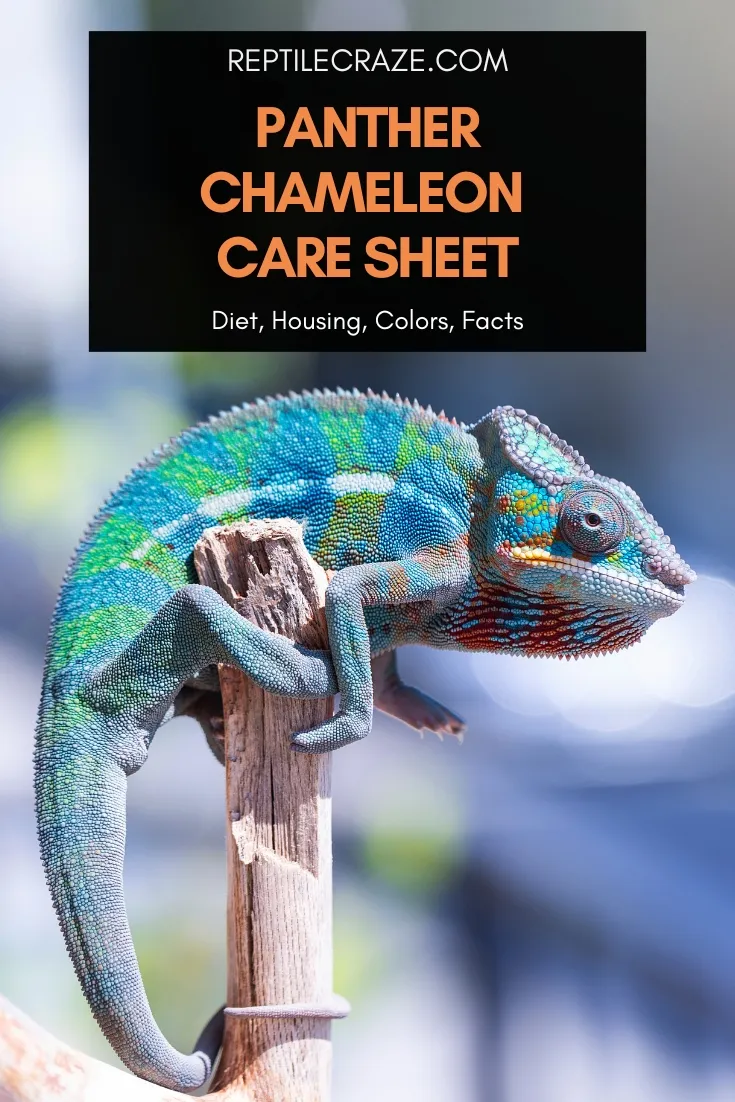
Panther chameleons are brilliant reptiles that entice reptile enthusiasts with their bright colors and exotic appearance. If you are an intermediate reptile owner, you can enjoy adding one of these beautiful creatures to your collection. Here is what you need to know about this breed.
Table of Contents
Panther Chameleon Facts
| Common Name | Panther chameleon |
| Scientific Name | Furcifer pardalis |
| Natural Habitat | Coastal Madagascar |
| Adult Size | 14-21” (male) or 9-13” (female) |
| Enclosure Size | 24” x 24” x 48” |
| Diet | Gut-loaded insects |
| Lifespan | 5-7 years |
| Experience Level | Intermediate |
Where Do Panther Chameleons Live?
Panther chameleons are mostly found in humid areas, most notably in the coastal areas near the Madagascar island.
They tend to prefer warmer climates and remain mostly in foliage that is near the floor. For the most part, they stick to small trees and bushes that allow them to be hidden from predators.
Panther Chameleon Appearance, Colors, and Morphs
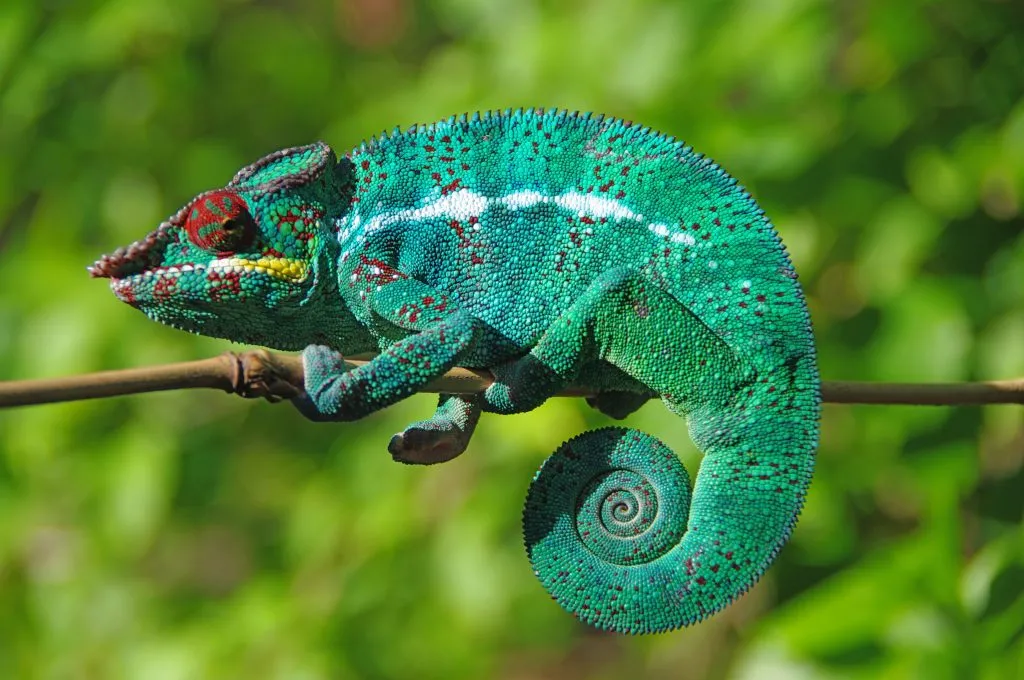
This reptile is known for its bright and flashy coloring with males being a bit more colorful than females. Males tend to come in shades of blue and green, though you may occasionally find a black panther chameleon.
Splashes of color can cover their body with spots of yellow, orange, and various shades of red and pink. You may also find that they have yellow mouths. Males often have a white stripe down their body.
On the other hand, females are commonly found in colors like tan, grey, or even a light green. This is one of the easiest ways to determine the difference between male and female.
There are several different panther chameleon locals. This means that they come from different areas in Madagascar and, therefore, have different color patterns. Here are the different locals you can get as pets:
- Furcifer Pardalis Ambanja
- Furcifer Pardalis Ambilobe
- Furcifer Pardalis Ampitabe
- Furcifer Pardalis Ankaramy
- Furcifer Pardalis Andapa
- Furcifer Pardalis Ankify
- Furcifer Pardalis Antalaha
- Furcifer Pardalis Antsiranana
- Furcifer Pardalis Beramanja
- Furcifer Pardalis Cap Est
- Furcifer Pardalis Djangoa
- Furcifer Pardalis Fenoarivo
- Furcifer Pardalis Mahavelona
- Furcifer Pardalis Mangaoka
- Furcifer Pardalis Manambato
- Furcifer Pardalis Maroantsetra
- Furcifer Pardalis Nosy Be
- Furcifer Pardalis Nosy Boraha
- Furcifer Pardalis Nosy Faly
- Furcifer Pardalis Nosy Misto
- Furcifer Pardalis Nosy Valiha
- Furcifer Pardalis Sambava
- Furcifer Pardalis Sambirano
- Furcifer Pardalis Tamatave
- Furcifer Pardalis Vohimana
You can see all these panther chameleon locals in the video below.
One of the most notable features that are prominent among all chameleons is their conical eyes. Each one moves independently of the other, allowing them to focus their attention on two things at once.
Don’t forget that their five toes are also fused together for climbing. On the outside, two toes are fused together, with three toes fused on the inside. This allows them to grip branches and climb into the foliage more easily.
How Big Do Panther Chameleons Get?
Male panther chameleons are a bit larger than females, coming in between 14 to 21 inches. The smaller female will usually measure anywhere from 9 to 13 inches when full-grown.
Panther Chameleon Lifespan
Most panther chameleons kept in captivity will live for roughly five years with males tending to live longer than their female counterparts.
Occasionally, captive panther chameleons have been noted to live up to seven years, but this is relatively rare.
How to Care for Panther Chameleons
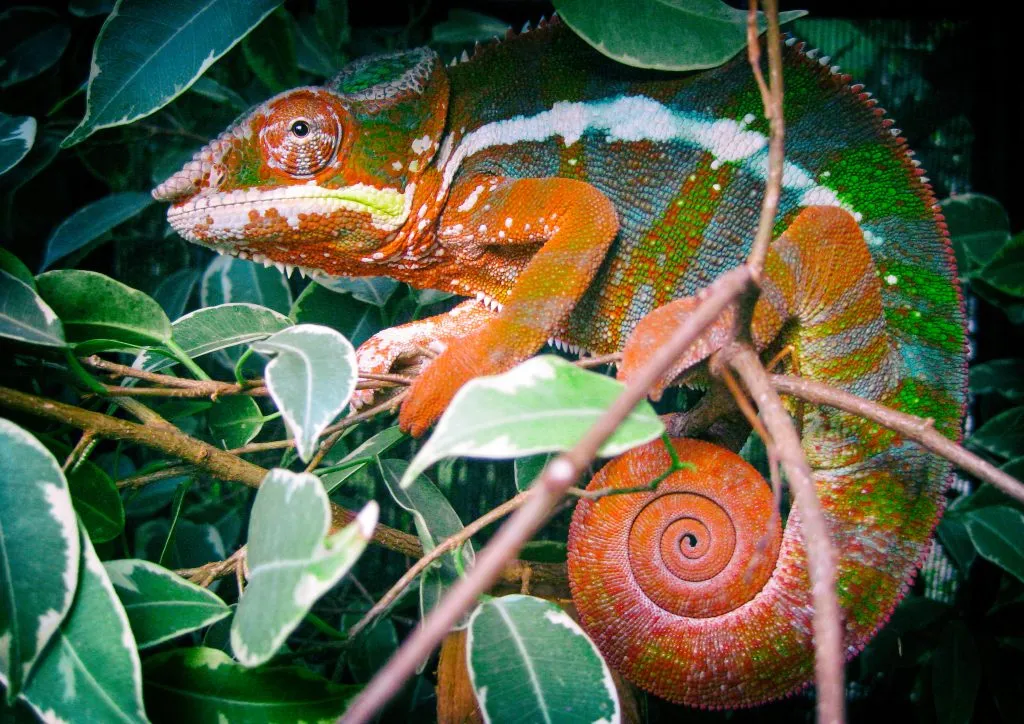
Panther Chameleon Tank Setup
Because of their large overall size, it is important to maintain an enclosure that is large enough. Keep in mind that these chameleons like to reside up off the forest floor, so you will need a
To this end, it is usually best to opt for an enclosure that is, at minimum, 24 inches wide by 24 inches long by 48 inches tall.
Lighting and Temperature
Your new panther chameleon will need some heat and light to function at its best. Aim to create a temperature gradient within the enclosure with a spot for basking as well as a cooler side.
In the basking spot, you can keep the temperature around 90°F (32°C) with a basking light like the Exo Terra Solar Glo.
Be sure to measure the temperature on the cool side of the enclosure as well. It should measure in the ballpark of 70°F (21°C).
Important to note is that panther chameleons are diurnal which means that they need both day and night to thrive.
This means that you should leave all lights off for roughly twelve hours each day while keeping the temperatures above 50°F (10°C).
You can do this by covering the enclosure with blankets or towels or keeping the ambient room temperature a little higher than usual.
Do Panther Chameleons Need UVB?
Panther chameleons do require UVB to keep their bones strong and develop healthily. You can combine both heat and UVB in one fell swoop using the Exo Terra Solar Glo, which provides a warm spot for basking and UVB all in one.
Substrate
Unlike many reptiles, panther chameleons do not require much in the way of substrate. This species requires high humidity levels and lots of moisture which can spell problems for most types of substrates.
Not to mention, panther chameleons spend very little time on the ground so substrate is not the most important aspect of the enclosure.
This means that you can use paper towels on the bottom of your enclosure which can easily be swapped out once saturated with water. You could also use dried moss, if desired.
Humidity

Panther chameleons are particularly sensitive to moisture in their enclosure. Daytime may not require as much attention with these chameleons needing 50% to 60% humidity.
However, these levels increase during the nighttime hours and should be kept between 75% to 100% humidity. As you might imagine, it can be difficult to monitor these humidity levels while you sleep.
To this end, you should invest in a humidifier that can run while you sleep in order to keep those humidity levels high. A reptile fogger humidifier helps you keep humidity levels high without the need for constant monitoring.
Panther Chameleon Tank Décor
Decorating your enclosure is about more than just aesthetics. It also serves to enrich the life of your new panther chameleon who enjoys spending time climbing and hiding.
To this end, you will want to include plenty of places for them to climb including vines or small branches. Investing in something like these 8-foot reptile vines is a must.
Make sure to leave the vines uncovered in some areas for a basking spot.
However, they also need foliage where they can hide and cool down, if necessary. Hanging plants like these Boston climbing terrarium plants or these Fluker’s Repta Vines are great options.
Make sure that they are securely attached to the sides of the enclosure so that they can hold the weight of your panther chameleon if it climbs up these plants.
How to Clean a Panther Chameleon Tank
For the most part, the only thing you will need to do on a daily basis is to spot clean the
If you are using paper towels as your substrate, it can be easy to lift them out and replace them with a fresh layer every couple of days.
Every week, you will need to do a deeper clean where you wipe down your panther chameleon’s favorite spots with a sponge soaked in hot water.
Roughly once a month, you might want to consider taking your enclosure apart and deep cleaning all of the foliage and walls.
You can soak your plants in a dish soap and water mixture, as long as you make sure to thoroughly rinse them before returning to the enclosure.
You can wipe down the inside of the terrarium with hot water and distilled white vinegar, as long as your chameleon is elsewhere when you do this.
Panther Chameleon Diet
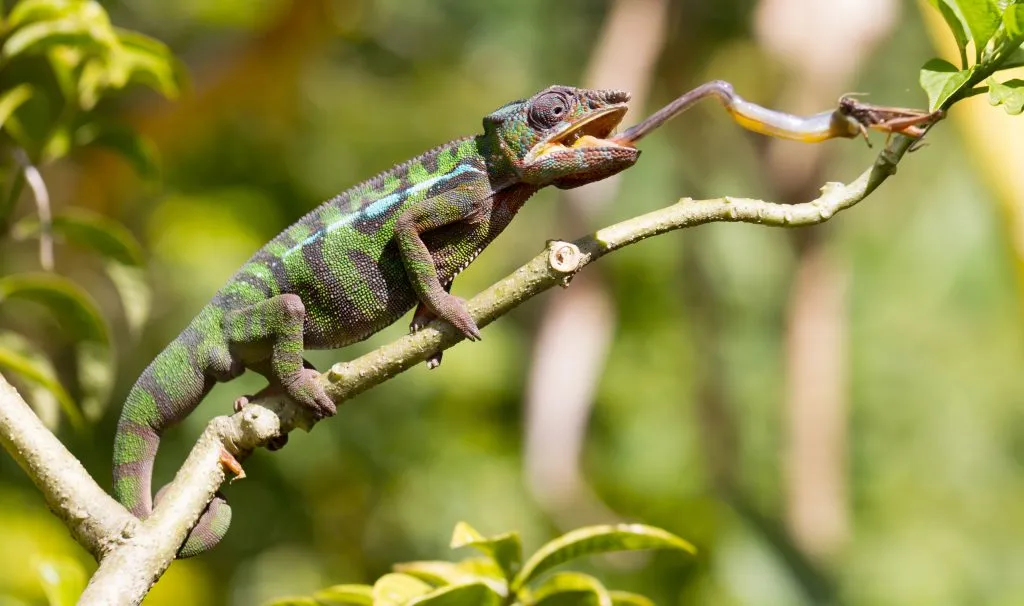
What to Feed
The panther chameleon diet is heavy on the insects, but they will eat a nice variety of them.
While many owners prefer to feed crickets, dubia roaches, or mealworms, these chameleons will also enjoy a tasty snack such as waxworms, grasshoppers, and silkworms.
As you might expect from their natural habitat, they also enjoy a feisty Madagascar roach from time to time.
The key to keeping your panther chameleon healthy via their diet is to feed gut-loaded insects.
How Often to Feed
How often to feed your panther chameleon depends primarily on their age. Juveniles are quite hungry, usually requiring you to feed them on a daily basis.
A good rule of thumb is to feed them as much as they are willing to eat at this stage of development.
When you notice that appetite is starting to flag or as they approach their first birthday, you can move to feeding them three to five insects every other day.
How Long Can Panther Chameleons Go Without Food ?
Feeding your panther chameleon regularly is a must if you want a healthy reptile. This species does not do well when
A week without a meal may lead to health issues related to malnourishment. That being said, many panther chameleons can go up to two weeks without food, though it won’t be without consequence.
Do Panther Chameleons Need Water?
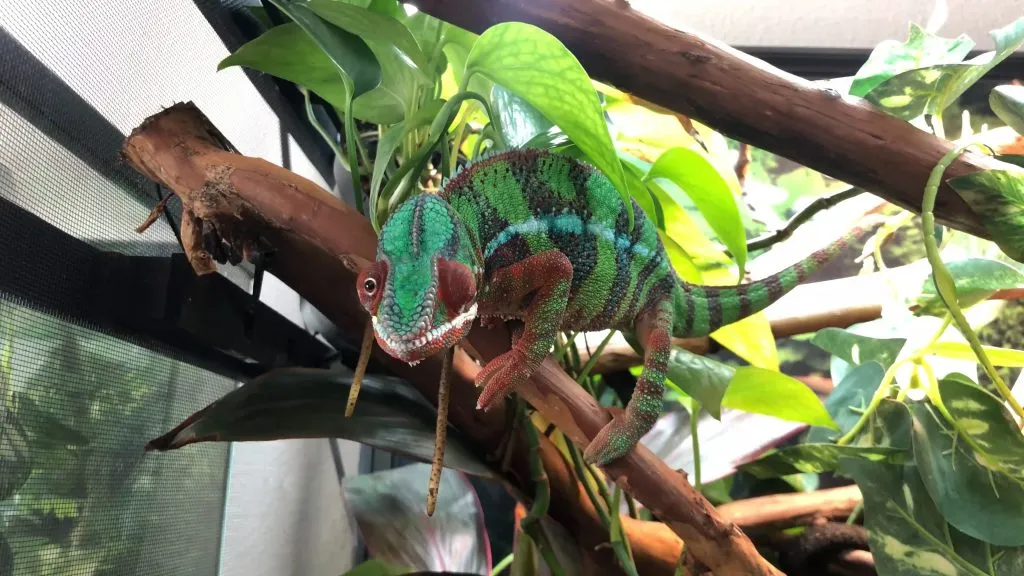
Your panther chameleon is particularly sensitive to how much water is in their enclosure. For the most part, you will not need to include a water dish. Instead, they are known for licking water off the leaves and plants in their enclosure.
This is why an automatic mister that keeps your
Not only does it keep the humidity levels high, but it also provides them with a fresh water source multiple times throughout the day and night to keep them hydrated.
If you choose not to use a mister, you should spray the cage down with water at least two to three times daily.
Vitamins and Minerals
Panther chameleons will get most of the vitamins and minerals they need from gut-loaded insects but some supplementation can help.
You can dust their
Panther Chameleon Behavior and Temperament
Panther chameleons tend to be very solitary reptiles, and many of them do not enjoy regular handling. For the most part, they would prefer you to look versus taking them out of their enclosure to play and handle them.
That being said, they are a little less aggressive than veiled chameleons are, but they will hiss when they are ready for you to back off.
One thing to keep in mind when it comes to their behavior is that they can be very territorial.
Keeping more than one panther chameleon in an enclosure (particularly if they are both males) can result in aggression and injury. You will know that they are feeling threatened if they start to change color or inflate themselves.
These reptiles will bite though it is relatively rare. If they start to demonstrate stress through color changes, hissing, or inflation, you should put them back in their enclosure to rest prior to allowing them to bite you.
Are Panther Chameleons Good Pets?

Some panther chameleons can become very tame and even want to climb on your arm whenever they see you, but most of them are rather shy pets.
If you don’t mind the fact that most panther chameleons are not huge fans of handling, then you might find that they are a great fit.
While not suitable for total beginners without doing lots of research upfront, they are great for intermediate reptile owners.
Their care and maintenance are relatively low, but they do have specific requirements to keep them happy and healthy.
Can You Handle Panther Chameleons?
You can handle your panther chameleon, though it is recommended to keep handling to a minimum.
Get them used to your presence by simply allowing your hand to rest in their
Even once they are used to you, you should only hold them for a few minutes at a time until they start to hiss or demonstrate stress. You may start to get them used to the idea of being held by hand feeding them.
For those who are determined to handle their panther chameleon, make sure to offer them the support they need.
Allow them to hold onto your hand as if it were a branch, not forcing them to move around if they aren’t comfortable with it. Refrain from petting them and allow them to just hang around you.
Panther Chameleon Common Health Problems
For the most part, panther chameleons aren’t prone to developing many serious health concerns. Those that do present themselves may be easily avoided, such as metabolic bone disease (which can be prevented with UVB lighting).
One issue that may pop up is endoparasites which are parasites that can take up residence inside of your panther chameleon. You might notice this if your panther chameleon has poor appetite, weight loss, vomiting, or even diarrhea.
Other common health problems include issues with the eyes and potential egg binding if you are breeding your chameleons.
Where to Buy Panther Chameleons
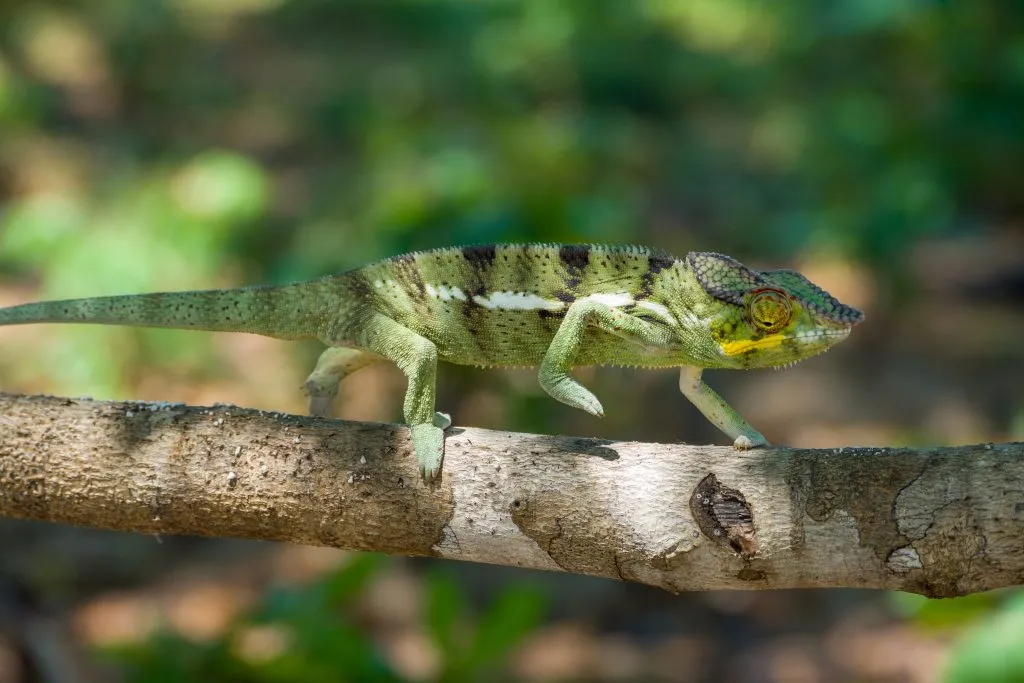
Panther Chameleon Breeders
Always purchase your panther chameleons from a reputable source. These top breeders will help you to get a healthy panther chameleon to add to your reptile collection:
Panther Chameleon Price
These are not inexpensive reptiles, so be prepared for a little bit of sticker shock when buying from a reputable breeder. Most will start around $300 and may increase for fancier colors and patterns. Some may cost up to $500 to $600.
Panther Chameleon Breeding
Panther chameleons can be bred as early as eight months (males) and one year (females).
You will know that your female is ready to mate when she turns to a pink color, at which point you can put her in an enclosure with a male.
Otherwise, they should be housed separately as they tend to be territorial. Males will respond to females with head-bobbing and advances.
Keep a close eye on things and remove the female if the male becomes too aggressive. Otherwise, they are fine to remain together for a day or two.
The gestation period is typically 20 to 30 days and a clutch of 20 or so eggs will be laid in a laying bin filled with moist soil. Eggs take roughly eight to twelve months to hatch.
Final Thoughts
Panther chameleons are a great addition to a reptile lover’s collection, but they are best suited to intermediate owners.
Enjoy their fancy colors and appearance, though they don’t much like to be handled. Consider whether this pet is the right addition to your family with these facts.
- Enchi Ball Python: A Unique and Stunning Morph of Python regius - March 27, 2025
- Emerald Tree Monitor: The Enigmatic Green Guardian of the Rainforest - March 26, 2025
- The Egyptian Cobra (Naja haje): A Fascinating Serpent - March 25, 2025
